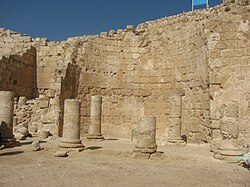| Some of this article's listed sources may not be reliable. Please help improve this article by looking for better, more reliable sources. Unreliable citations may be challenged and removed. (May 2020) (Learn how and when to remove this message) |
| Herod's Palace | |
|---|---|
 Lobby of Herod's northern palace Lobby of Herod's northern palace | |
 | |
| General information | |
| Type | Palace |
| Location | Herodium, West Bank, Israel |
| Coordinates | 31°39′57″N 35°14′29″E / 31.66583°N 35.24139°E / 31.66583; 35.24139 |
| Opened | 23-15 BCE |
| Owner | Herod the Great |
Herod's Palace is an archaeological site within the fortress of Herodium, West Bank, Palestine
Construction
Archaeologists believe that the palace was built by slaves, paid workers (contractors), and architects. Herod was considered one of the greatest builders of his time, and geography did not daunt him—his palace was built on the edge of the desert and was situated atop an artificial hill. The largest of the four towers was built on a stone base 18 meters in diameter. This was most likely where Herod lived; he decorated his rooms with mosaic floors and elaborate frescoes. The other three towers, which consisted of living spaces and storage, were 16 meters in diameter. Outside, several cisterns were built to collect water that was channeled into the palace.
Excavation
The archaeological excavation of Herodium was begun in 1962 by Virgilio Canio Corbo and Stanislao Loffreda, from the Studium Biblicum Franciscanum of Jerusalem, and it continued until 1967: they discovered the upper citadel, at the top of the hill.
From 1972, excavations were carried out by Ehud Netzer, working on behalf of the Hebrew University of Jerusalem, and they were intermittent until the archaeologist's death in 2010. Netzer excavated mostly the lower palace, at the base of the hill.
Many archaeologists suspect that mosaic floors and frescoes were common throughout the palace, but it will take more work to reveal them because of the thousands of years that have passed since its construction.
Excavated areas
Bathhouse
The Roman bathhouse consisted of three areas, the caldarium, the tepidarium, and the frigidarium. It also had a very impressive dome which is still in good condition today despite thousands of years of earthquakes and wars. The caldarium had vaulted ceilings, raised floors, and channels in the walls to conduct heat. The tepidarium had mosaic floors and frescoes just like the living quarters of the palace. The frigidarium, the last stop in the bathhouse, was where guests would cool off in a large pool.
Roman Theatre
Netzer discovered the Roman Theatre just before his death in late 2010. A loggia, or a theatre box, was discovered. This means that when Herod or other notable officials went to see a play, they would receive luxury treatment. The rest of the audience would be seated below on benches that could accommodate about 650 people. What is quite unique about this find is that frescoes of landscapes were discovered. This suggests that the painters were well traveled; they depict scenes of Italy and even the Nile River in Egypt. It is also assumed that the painters were on loan to Herod from Caesar in Rome.
See also
References
- "King Herod's Palace and Refuge". Israel Nature and Parks Authority. Archived from the original on 12 January 2012. Retrieved 1 December 2011.
- On the historical circumstances of the building of Herodium, see: Jonathan Bourgel & Roi Porat, "Herodium as a Reflection of Herod’s Policy in Judea and Idumea," Zeitschrift des Deutschen Palästina-Vereins 135/2 (2019), 188-209.
- ^ Mueller, Tom (December 2008). "Herod: The Holy Land's Visionary Builder". National Geographic.
- ^ Browns, Shmuel. "A Visit to the Herodium and Herod's Tomb". Word Press. Retrieved 17 November 2011.
- Virginio Canio Corbo, Herodion. I: Gli edifici della reggia-fortezza, Jerusalem 1989
- "Herodium - King Herod's Palace-Fortress". Israel Ministry of Foreign Affairs. Retrieved 17 November 2011.
- Milstein, Mati. "Luxury Box Seating". Archaeological Institute of America. Retrieved 17 November 2011.
- Magness, Jodi (2001). "Where Is Herod's Tomb At Herodium?". Bulletin of the American Schools of Oriental Research: 43.